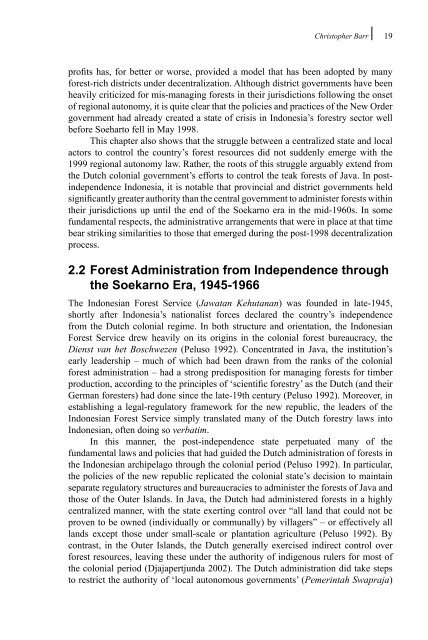Decentralization of Forest Administration in Indonesia, Implications ...
Decentralization of Forest Administration in Indonesia, Implications ...
Decentralization of Forest Administration in Indonesia, Implications ...
Create successful ePaper yourself
Turn your PDF publications into a flip-book with our unique Google optimized e-Paper software.
Christopher Barr 19<br />
pr<strong>of</strong>its has, for better or worse, provided a model that has been adopted by many<br />
forest-rich districts under decentralization. Although district governments have been<br />
heavily criticized for mis-manag<strong>in</strong>g forests <strong>in</strong> their jurisdictions follow<strong>in</strong>g the onset<br />
<strong>of</strong> regional autonomy, it is quite clear that the policies and practices <strong>of</strong> the New Order<br />
government had already created a state <strong>of</strong> crisis <strong>in</strong> <strong>Indonesia</strong>’s forestry sector well<br />
before Soeharto fell <strong>in</strong> May 1998.<br />
This chapter also shows that the struggle between a centralized state and local<br />
actors to control the country’s forest resources did not suddenly emerge with the<br />
1999 regional autonomy law. Rather, the roots <strong>of</strong> this struggle arguably extend from<br />
the Dutch colonial government’s efforts to control the teak forests <strong>of</strong> Java. In post<strong>in</strong>dependence<br />
<strong>Indonesia</strong>, it is notable that prov<strong>in</strong>cial and district governments held<br />
significantly greater authority than the central government to adm<strong>in</strong>ister forests with<strong>in</strong><br />
their jurisdictions up until the end <strong>of</strong> the Soekarno era <strong>in</strong> the mid-1960s. In some<br />
fundamental respects, the adm<strong>in</strong>istrative arrangements that were <strong>in</strong> place at that time<br />
bear strik<strong>in</strong>g similarities to those that emerged dur<strong>in</strong>g the post-1998 decentralization<br />
process.<br />
2.2 <strong>Forest</strong> <strong>Adm<strong>in</strong>istration</strong> from Independence through<br />
the Soekarno Era, 1945-1966<br />
The <strong>Indonesia</strong>n <strong>Forest</strong> Service (Jawatan Kehutanan) was founded <strong>in</strong> late-1945,<br />
shortly after <strong>Indonesia</strong>’s nationalist forces declared the country’s <strong>in</strong>dependence<br />
from the Dutch colonial regime. In both structure and orientation, the <strong>Indonesia</strong>n<br />
<strong>Forest</strong> Service drew heavily on its orig<strong>in</strong>s <strong>in</strong> the colonial forest bureaucracy, the<br />
Dienst van het Boschwezen (Peluso 1992). Concentrated <strong>in</strong> Java, the <strong>in</strong>stitution’s<br />
early leadership – much <strong>of</strong> which had been drawn from the ranks <strong>of</strong> the colonial<br />
forest adm<strong>in</strong>istration – had a strong predisposition for manag<strong>in</strong>g forests for timber<br />
production, accord<strong>in</strong>g to the pr<strong>in</strong>ciples <strong>of</strong> ‘scientific forestry’ as the Dutch (and their<br />
German foresters) had done s<strong>in</strong>ce the late-19th century (Peluso 1992). Moreover, <strong>in</strong><br />
establish<strong>in</strong>g a legal-regulatory framework for the new republic, the leaders <strong>of</strong> the<br />
<strong>Indonesia</strong>n <strong>Forest</strong> Service simply translated many <strong>of</strong> the Dutch forestry laws <strong>in</strong>to<br />
<strong>Indonesia</strong>n, <strong>of</strong>ten do<strong>in</strong>g so verbatim.<br />
In this manner, the post-<strong>in</strong>dependence state perpetuated many <strong>of</strong> the<br />
fundamental laws and policies that had guided the Dutch adm<strong>in</strong>istration <strong>of</strong> forests <strong>in</strong><br />
the <strong>Indonesia</strong>n archipelago through the colonial period (Peluso 1992). In particular,<br />
the policies <strong>of</strong> the new republic replicated the colonial state’s decision to ma<strong>in</strong>ta<strong>in</strong><br />
separate regulatory structures and bureaucracies to adm<strong>in</strong>ister the forests <strong>of</strong> Java and<br />
those <strong>of</strong> the Outer Islands. In Java, the Dutch had adm<strong>in</strong>istered forests <strong>in</strong> a highly<br />
centralized manner, with the state exert<strong>in</strong>g control over “all land that could not be<br />
proven to be owned (<strong>in</strong>dividually or communally) by villagers” – or effectively all<br />
lands except those under small-scale or plantation agriculture (Peluso 1992). By<br />
contrast, <strong>in</strong> the Outer Islands, the Dutch generally exercised <strong>in</strong>direct control over<br />
forest resources, leav<strong>in</strong>g these under the authority <strong>of</strong> <strong>in</strong>digenous rulers for most <strong>of</strong><br />
the colonial period (Djajapertjunda 2002). The Dutch adm<strong>in</strong>istration did take steps<br />
to restrict the authority <strong>of</strong> ‘local autonomous governments’ (Pemer<strong>in</strong>tah Swapraja)

















